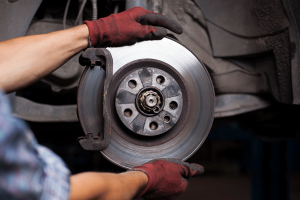
Fixing the brakes
Brake repair signs are important to notice. You may start to notice when a repair would be needed. An uneven rotor surface may also cause the rotor to hit one of the brake pads as it spins, causing some of the pad material to transfer onto the rotor in that spot. Then you’ll feel shaking when braking, as the pad hits that bump in the rotor.
Another possible cause of rough braking is the brake caliper not releasing properly. The job of a brake caliper is to squeeze the brake pads against your brake rotors, which slows your vehicle down. It’s the motion of the piston inside the caliper unit that causes this contact. Due to wear from heat or road debris, the piston can get sticky. It may not retract the pads back into the full off position when you let up on the brake pedal.
Another cause of bumpy braking could be damage to your brake components from improper wheel lug nut installation. Any time tires are removed, it’s crucial for the lug nuts to be put back on in the right order, evenly, at just the right tightness, or torque.
Leaking Fluid
If you are experiencing a soft brake pedal, look for fluid leaking from the master cylinder or elsewhere in the brake system. The master cylinder is the unit that creates the power for your brakes. It has a reservoir like the one for your wiper fluid that contains brake fluid. When you apply the brakes, this fluid is pushed through thin piping, creating hydraulic pressure. If fluid is leaking from this system, there may not be enough power to force the brake pads to clamp hard to the rotors.
Spongy or Soft Brake Pedal
If you notice a difference in the resistance in the brake pedal, there could be an issue. It may include the pedal feeling softer sinking all the way to the floor mat when you press on it. There could also be air or moisture in the braking system or a problem with the master cylinder.
Recent Comments